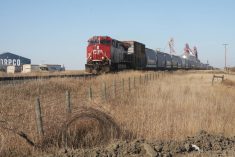Western Producer staff
(Shein is managing editor of the Western Producer, and last week covered the annual meeting of the Canada Grains Council in Vancouver.)
A paper released by CP Rail Systems lists what the railway company considers caused the problems for Canada’s grain transportation system this past year:
- The former Soviet Union and China were Canada’s largest and most dependable grains markets. Russia is gone from the market and China is buying less grain than normal. The result is Canadian grain markets have become significantly more volatile and logistically more demanding.
- Western Canadian production of the six major grains (wheat, barley, canola, rye, oats and flax) was 48.7 million tonnes for the 1993-94 crop year, compared to the 10-year average of 42.8 million tonnes.
- A very high percentage of that grain was feed wheat; a wet summer led to delayed harvests and made November and December exceptionally busy shipping months. The late crop compressed the port of Thunder Bay’s shipping season to two months from the normal three, pushing up demand for hopper cars.
- The crop year had significant changes in crop mix, with specialty crops unusually high. For example, at 5.4 million tonnes, canola production was well above its 10-year average of 3.6 million tonnes. This led to complex handling, cleaning and transporting of the crops. Compared to traditional wheat board grains, these commodities and feed wheat required considerably more rail handling and increased car cycle times. This reduced the existing hopper car fleet. In some months, up to 40 percent of the grain CP Rail was moving to Thunder Bay consisted of these “handling intensive” commodities.
- The full volume of late fall sales of these commodities had not been anticipated or forecast by the trade and so had not been factored into railway assessments or planning for hopper car demand.
- The summer flooding of the Missouri and Mississippi river systems meant the American grain transportation system couldn’t use barges. This led to increased rail movements of grain and increase pressure on North American rail car supply.
- The flooding, along with rainy weather in other growing areas and a severe drought in southeastern U.S. destroyed crops that normally supplied American processors and feeders, especially feed grains and oilseeds. The Canadians took advantage of the situation and developed new U.S. markets.
- The U.S. also continued to provide very large payments under its Export Enhancement Program which subsidized offshore exports even to the extent of creating shortages for certain grains in the U.S. market. This led to more Canadian sales.
- The above factors led to more rail movement into the U.S., increasing demand for hopper cars and leading to longer cycle times, which were two to three times longer than to the Canadian export ports of Thunder Bay and Vancouver.
- The poor American corn and soybean crops also disrupted normal grain shipping patterns across North America, as grain-consuming regions sought to find grain from more distant non-traditional supply regions. This persisted through the winter well after floods receded in the U.S.
- Strong fertilizer demand, created in part by the need to replace soil nutrients leached out by Mississippi flooding and excess rainfall also affected hopper car markets.
- Grain sales to U.S. and offshore markets were strong during the winter months. However, the unusually severe winter throughout North America, combined with the 12-day work stoppage in the port of Vancouver, made grain shipment difficult.
Read Also

Agriculture needs to prepare for government spending cuts
As government makes necessary cuts to spending, what can be reduced or restructured in the budgets for agriculture?
Forecast movements off the West Coast are for record levels that have never been achieved on a sustained basis by the grain transportation and handling system.
The challenge for the industry is much greater this year given the uncertain labor environment faced by the grain elevators in Vancouver, particularly as it affects weekend unloading, and the unique logistic complexities of handling this year’s crop mix.
In summary, the current situation is the product of a series of seemingly unrelated and distinctly unusual circumstances all coming together at the same time. A repeat of all these events is unlikely.
















